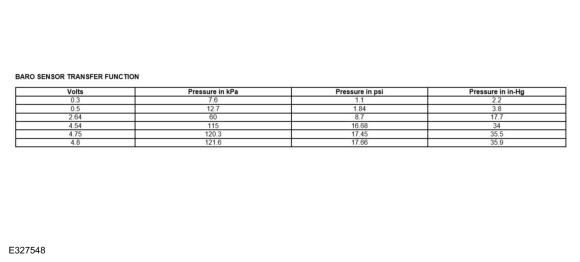Lincoln Navigator: Intake Air Distribution and Filtering - 3.5L EcoBoost (272kW/370PS) / Intake Air Pressure and Temperature. Diagnosis and Testing
Diagnostic Trouble Code (DTC) Chart
Diagnostics in this manual assume a certain skill level and knowledge of Ford-specific diagnostic practices.
REFER to: Diagnostic Methods (100-00 General Information, Description and Operation).
| Module | DTC | Description | Action |
|---|---|---|---|
| PCM | P007A:00 | Charge Air Cooler Temperature Sensor Circuit (Bank 1): No Sub Type Information | GO to Pinpoint Test DN |
| PCM | P007B:00 | Charge Air Cooler Temperature Sensor Circuit Range/Performance (Bank 1): No Sub Type Information | GO to Pinpoint Test DN |
| PCM | P007C:00 | Charge Air Cooler Temperature Sensor Circuit Low (Bank 1): No Sub Type Information | GO to Pinpoint Test DN |
| PCM | P007D:00 | Charge Air Cooler Temperature Sensor Circuit High (Bank 1): No Sub Type Information | GO to Pinpoint Test DN |
| PCM | P0096:00 | Intake Air Temperature Sensor 2 Circuit Range/Performance (Bank 1): No Sub Type Information | GO to Pinpoint Test DN |
| PCM | P0097:00 | Intake Air Temperature Sensor 2 Circuit Low (Bank 1): No Sub Type Information | GO to Pinpoint Test DN |
| PCM | P0098:00 | Intake Air Temperature Sensor 2 Circuit High (Bank 1): No Sub Type Information | GO to Pinpoint Test DN |
| PCM | P00CE:00 | Intake Air Temperature Measurement System - Multiple Sensor Correlation (Bank 1): No Sub Type Information | GO to Pinpoint Test DN |
| PCM | P0106:00 | Manifold Absolute Pressure/Barometric Pressure Sensor Circuit Range/Performance: No Sub Type Information | GO to Pinpoint Test DM |
| PCM | P0107:00 | Manifold Absolute Pressure/Barometric Pressure Sensor Circuit Low: No Sub Type Information | GO to Pinpoint Test DM |
| PCM | P0108:00 | Manifold Absolute Pressure/Barometric Pressure Sensor Circuit High: No Sub Type Information | GO to Pinpoint Test DM |
| PCM | P0109:00 | Manifold Absolute Pressure/Barometric Pressure Sensor Circuit Intermittent: No Sub Type Information | GO to Pinpoint Test DM |
| PCM | P0235:00 | Turbocharger/Supercharger Boost Sensor 'A' Circuit: No Sub Type Information | GO to Pinpoint Test DM |
| PCM | P0236:00 | Turbocharger/Supercharger Boost Sensor 'A' Circuit Range/Performance: No Sub Type Information | GO to Pinpoint Test DM |
| PCM | P0237:00 | Turbocharger/Supercharger Boost Sensor 'A' Circuit Low: No Sub Type Information | GO to Pinpoint Test DM |
| PCM | P0238:00 | Turbocharger/Supercharger Boost Sensor 'A' Circuit High: No Sub Type Information | GO to Pinpoint Test DM |
| PCM | P2227:00 | Barometric Pressure Sensor 'A' Circuit Range/Performance: No Sub Type Information | GO to Pinpoint Test DO |
| PCM | P2228:00 | Barometric Pressure Sensor 'A' Circuit Low: No Sub Type Information | GO to Pinpoint Test DO |
| PCM | P2229:00 | Barometric Pressure Sensor 'A' Circuit High: No Sub Type Information | GO to Pinpoint Test DO |
| PCM | U060B:00 | Lost Communication With Turbocharger/Supercharger Boost Sensor 'A': No Sub Type Information | GO to Pinpoint Test DM |
| PCM | U066D:00 | Lost Communication With Charge Air Cooler Temperature Sensor Bank 1: No Sub Type Information | GO to Pinpoint Test DN |
Global Customer Symptom Code (GCSC) Chart
Diagnostics in this manual assume a certain skill level and knowledge of Ford-specific diagnostic practices.
REFER to: Diagnostic Methods (100-00 General Information, Description and Operation).
| Symptom | Action |
|---|---|
| Driving Performance > Runs Rough > Acceleration > Always | GO to Pinpoint Test DM |
| Driving Performance > Runs Rough > Cruise/ Steady Speed > Always | GO to Pinpoint Test DM |
| Driving Performance > Runs Rough > Deceleration > Always | GO to Pinpoint Test DM |
| Driving Performance > Runs Rough > All Running Modes > Always | GO to Pinpoint Test DM |
| Driving Performance > Idle Quality > Fast > Always | GO to Pinpoint Test DM |
| Driving Performance > Idle Quality > Rolling > Always | GO to Pinpoint Test DM |
| Driving Performance > Idle Quality > Slow > Always | GO to Pinpoint Test DM |
| Driving Performance > Idle Quality > Slow Return > Always | GO to Pinpoint Test DM |
| Driving Performance > Idle Quality > Rough > Always | GO to Pinpoint Test DM |
| Driving Performance > Stalls/Quits > At Idle > Always | GO to Pinpoint Test DM |
| Driving Performance > Stalls/Quits > Acceleration > Always | GO to Pinpoint Test DM |
| Driving Performance > Stalls/Quits > Cruise/ Steady Speed > Always | GO to Pinpoint Test DM |
| Driving Performance > Hesitates/Stumble > Cruise/ Steady Speed > Always | GO to Pinpoint Test DM |
| Driving Performance > Engine Surge > At Idle > Always | GO to Pinpoint Test DM |
| Driving Performance > Engine Surge > Acceleration > Always | GO to Pinpoint Test DM |
| Driving Performance > Engine Surge > Cruise/ Steady Speed > Always | GO to Pinpoint Test DM |
| Driving Performance > Engine Surge > Deceleration > Always | GO to Pinpoint Test DM |
Pinpoint Tests

 PINPOINT TEST DM: MANIFOLD PRESSURE SENSORS
PINPOINT TEST DM: MANIFOLD PRESSURE SENSORS


  Introduction Introduction
NOTE: Refer to the appropriate Wiring Diagrams Cell for schematic and connector information Normal Operation and Fault Conditions Refer to the DTC Fault Trigger Conditions. DTC Fault Trigger Conditions
Possible Sources
|

 PINPOINT TEST DN: PRESSURE AND TEMPERATURE SENSORS
PINPOINT TEST DN: PRESSURE AND TEMPERATURE SENSORS


  Introduction Introduction
NOTE: Refer to the appropriate Wiring Diagrams Cell for schematic and connector information Normal Operation and Fault Conditions Voltage values calculated for VREF equals 5 volts. These values can vary by 15% due to sensor and VREF variations. Refer to the DTC Fault Trigger Conditions. DTC Fault Trigger Conditions
Possible Sources
|

 PINPOINT TEST DO: BAROMETRIC PRESSURE (BARO) SENSOR
PINPOINT TEST DO: BAROMETRIC PRESSURE (BARO) SENSOR


  Introduction Introduction
NOTE: Refer to the appropriate Wiring Diagrams Cell for schematic and connector information Normal Operation and Fault Conditions 
Refer to the DTC Fault Trigger Conditions. DTC Fault Trigger Conditions
Possible Sources
|
 Intake Air Flow. Diagnosis and Testing
Intake Air Flow. Diagnosis and Testing
Diagnostic Trouble Code (DTC) Chart
Diagnostics in this manual assume a certain skill level and knowledge of Ford-specific diagnostic practices. REFER to: Diagnostic Methods (100-00 General Information, Description and Operation)...
 Charge Air Cooler (CAC) Cleaning. General Procedures
Charge Air Cooler (CAC) Cleaning. General Procedures
Materials
Name
Specification
Motorcraft® Metal Brake Parts CleanerPM-4-A, PM-4-B, APM-4-C
-
Cleaning
NOTICE:
Do not use a high-pressure power washer to clean the CAC or damage to the CAC may occur...
Other information:
Lincoln Navigator 2018-2025 Workshop Manual: Front Bumper Cover. Removal and Installation
Removal NOTE: Removal steps in this procedure may contain installation details. Remove the front wheels and tires. Refer to: Wheel and Tire (204-04A Wheels and Tires, Removal and Installation). Remove the front bumper cover lower trim pins...
Lincoln Navigator 2018-2025 Workshop Manual: Fuel System. Diagnosis and Testing
Symptom Chart(s) Symptom Chart: Fuel System Diagnostics in this manual assume a certain skill level and knowledge of Ford-specific diagnostic practices. REFER to: Diagnostic Methods (100-00 General Information, Description and Operation). for information regarding Ford-specific diagnostic practices...
Categories
- Manuals Home
- 4th Gen Lincoln Navigator Service Manual (2018 - 2025)
- Windshield Washer Pump. Removal and Installation
- Liftgate Trim Panel. Removal and Installation
- Power Running Board (PRB). Diagnosis and Testing
- Telematics Control Unit (TCU) Module. Removal and Installation
- Transmission Fluid Drain and Refill. General Procedures
Rear Stabilizer Bar Link. Removal and Installation
Removal
NOTE: Removal steps in this procedure may contain installation details.
With the vehicle in NEUTRAL, position it on a hoist.Refer to: Jacking and Lifting (100-02 Jacking and Lifting, Description and Operation).
NOTE: Use the hex-holding feature to prevent the stud from turning while removing the nut.
Remove and discard the 2 rear stabilizer bar link nuts and remove the rear stabilizer bar link.Torque: 46 lb.ft (63 Nm)

